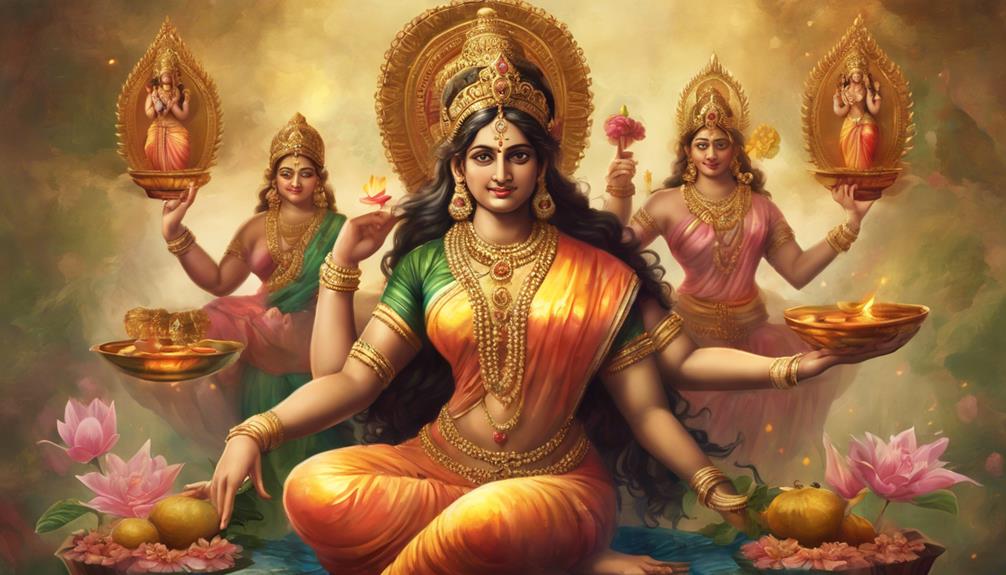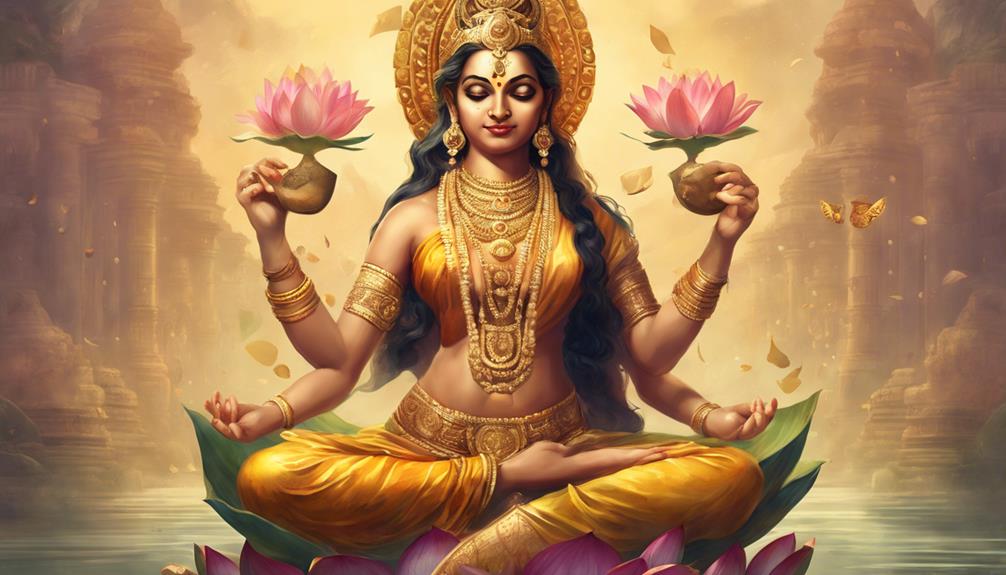Discover the intricate tapestry of Goddess Lakshmi's various forms – Maha Lakshmi embodying wealth and generosity, Gaja Lakshmi symbolizing fertility and agricultural prosperity, and Ashta Lakshmi encompassing different types of wealth. Each manifestation signifies essential aspects of human life – children, courage, victory, knowledge, and food. The depictions of Lakshmi with four hands and various attributes represent the deep symbolism of wealth, abundance, strength, grace, and inner strength. Immerse yourself in the rich symbolism and significance of each form to reveal the profound layers of divine grace and blessings awaiting you.
Table of Contents
Key Takeaways
- Mahalakshmi embodies sacred beauty and divine grace.
- Adi Lakshmi symbolizes symbolic richness and auspicious blessings.
- Dhana Lakshmi represents material wealth and abundance.
- Gaja Lakshmi embodies strength, grace, and regality.
- Veera Lakshmi symbolizes courage, valor, and inner strength.
Manifestations of Goddess Lakshmi
Explore the myriad manifestations of Goddess Lakshmi, each imbued with profound symbolism and rooted in historical significance. Known for her divine energies and association with abundance, Goddess Lakshmi embodies feminine power and prosperity in various forms. One prominent manifestation is Maha Lakshmi, the ultimate form of the goddess representing wealth, fortune, and generosity. She's often depicted with four hands symbolizing dharma, artha, kama, and moksha, essential aspects of human life.
Another significant form is Gaja Lakshmi, where the goddess is seen sitting on a lotus and flanked by two elephants showering her with water symbolizing fertility, rain, and the importance of water for sustenance. This form emphasizes the connection between Lakshmi and agricultural prosperity. Additionally, Ashta Lakshmi, the eightfold form of the goddess, represents different types of wealth, including children, courage, victory, knowledge, and food, showcasing the multifaceted nature of abundance and prosperity in Hindu mythology.
Symbolism of Lakshmis Forms
In the diverse forms of Goddess Lakshmi, each intricately symbolizes different aspects of abundance, femininity, and prosperity deeply rooted in historical and mythological significance. One of her forms, Mahalakshmi, embodies sacred beauty and divine grace, representing the epitome of beauty and benevolence.
Another form, Adi Lakshmi, symbolizes symbolic richness and auspicious blessings, signifying the primal source of wealth and prosperity.
Lakshmi in her form as Dhana Lakshmi represents material wealth and abundance, while Gaja Lakshmi embodies strength, grace, and regality like that of an elephant.
Veera Lakshmi symbolizes courage and valor, highlighting the importance of inner strength and resilience in the face of challenges.
These various forms of Lakshmi collectively depict the multifaceted nature of abundance and prosperity, each form adding a layer of depth to the understanding of wealth in its diverse manifestations throughout history and mythology.
Spiritual Significance of Lakshmis Avatars

As the forms of Goddess Lakshmi intricately symbolize different aspects of abundance and prosperity, delving into the spiritual significance of her avatars reveals a profound connection to deeper spiritual domains and symbolic representations. Lakshmi's avatars are embodiments of divine abundance and prosperity personified. Each avatar carries unique qualities and symbolism that resonate with different aspects of wealth and spiritual growth.
One of Lakshmi's avatars is Adi Lakshmi, representing primordial energy and the source of all existence. She symbolizes the beginning of creation and the eternal flow of abundance in the universe. Another significant avatar is Dhana Lakshmi, the goddess of material wealth and prosperity. She bestows her devotees with financial stability and success in their endeavors.
Furthermore, Veera Lakshmi embodies courage, strength, and victory. She empowers individuals to overcome obstacles and achieve success through perseverance and determination. These avatars of Lakshmi offer spiritual guidance and blessings, reminding us of the importance of balance, gratitude, and the pursuit of prosperity in all its forms.
Interpretations of Lakshmis Various Depictions
Symbolism and historical context intertwine in the various depictions of Goddess Lakshmi, offering profound insights into the spiritual significance of each portrayal. Different interpretations of Lakshmi's various depictions showcase her divine symbolism in unique ways. For instance, when depicted with gold coins flowing from her hands, she symbolizes wealth and prosperity. This portrayal represents not only material abundance but also spiritual wealth and well-being.
Another common depiction shows her holding lotus flowers, symbolizing purity, beauty, and fertility. The lotus is also significant in Hindu mythology as a symbol of divine beauty and grace emerging from the murky waters of the material world.
Additionally, Lakshmi is often portrayed sitting or standing on a blooming lotus, signifying transcendence and liberation from worldly attachments. Each representation of Goddess Lakshmi conveys deep spiritual meanings, inviting devotees to contemplate the divine symbolism inherent in her various forms.
Understanding Lakshmis Diverse Representations

Exploring the diverse representations of Goddess Lakshmi reveals a rich tapestry of symbolism and historical significance intricately woven into each portrayal. Lakshmi is depicted in various forms, each representing different divine attributes and cultural significance.
One of her popular forms is 'Sri', symbolizing wealth, prosperity, and abundance. In this form, she's adorned with gold jewelry and lotus flowers, signifying purity and fertility.
Another representation is 'Gaja Lakshmi', where she's surrounded by elephants, representing royalty, strength, and power. 'Dhana Lakshmi' showcases her as the giver of wealth and fortune, often depicted holding a pot overflowing with gold coins.
These diverse forms of Lakshmi not only highlight her role as the goddess of wealth but also emphasize her association with auspiciousness and prosperity in various aspects of life. Understanding these representations provides insight into the multifaceted nature of Lakshmi and her enduring significance in Hindu culture and spirituality.
Frequently Asked Questions
Can Goddess Lakshmi's Forms Be Worshipped Individually or Is It Necessary to Worship All of Her Manifestations?
You can worship Goddess Lakshmi's forms individually or collectively. Each form holds unique significance and symbolism. While worshipping all forms during festivals like Diwali is common, individual worship of a specific form is also encouraged.
Are There Specific Rituals or Prayers Associated With Each Form of Goddess Lakshmi?
Specific rituals and prayers are linked to each form of Goddess Lakshmi. These practices vary depending on the manifestation being worshipped, highlighting unique attributes and qualities associated with each aspect of the deity.
How Do the Different Forms of Lakshmi Relate to Each Other in Terms of Their Symbolism and Significance?
In understanding the different forms of Lakshmi, you'll discover interconnected symbolism that links them. Ritualistic practices associated with each form highlight their significance in Hindu mythology. Each form represents unique aspects of prosperity, wealth, and well-being.
Are There Any Particular Festivals or Celebrations Dedicated to Each Form of Goddess Lakshmi?
In various festivals and customs, devotees honor specific forms of Goddess Lakshmi, celebrating her diverse symbolism and significance. Each form brings unique blessings and teachings, enriching the spiritual and cultural tapestry of devotees.
Is There a Specific Mantra or Chant That Is Recommended for Invoking the Blessings of Each Manifestation of Lakshmi?
To invoke each form of Lakshmi, chant specific mantras with devotion. The benefits of these mantras are immense, aiding in attracting prosperity and abundance. Through ritualistic worship practices, one can connect deeply with the divine energy of Goddess Lakshmi.
Conclusion
To sum up, the different forms of Goddess Lakshmi serve as powerful symbols of prosperity, abundance, and spiritual wealth in Hindu mythology. Each manifestation carries its own unique symbolism and significance, providing devotees with a rich tapestry of spiritual teachings and guidance.
By understanding the diverse representations of Lakshmi, one can cultivate a deeper connection to the divine feminine energy and invite prosperity into their lives in various forms. Embrace the goddess in all her forms and experience the blessings she bestows upon those who seek her grace.